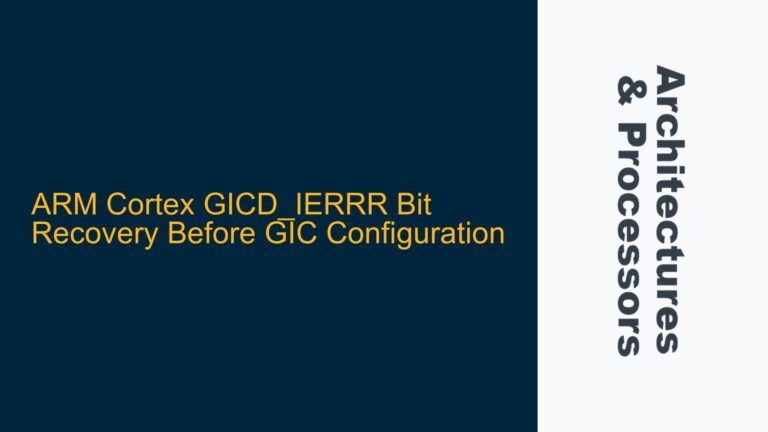AXI4 Write Data Arriving Before Write Address Due to Register Stage Imbalance
In the AXI4 protocol, the relationship between the write address (AW) channel and the write data (W) channel is critical for ensuring correct data transfer and system functionality. A unique characteristic of the AXI4 protocol is that the write data can arrive at the slave interface before the corresponding write address. This scenario occurs when the write address channel contains more register stages than the write data channel, or when the address path is more complex and requires additional pipelining to meet timing requirements. This behavior is explicitly allowed by the AXI4 specification, but it introduces challenges in design and verification, particularly in ensuring that the slave can correctly associate the incoming data with the appropriate address.
The need for register stages arises from the physical constraints of the design, such as long routing paths, high fanout, or complex combinatorial logic in the address calculation. These factors can cause timing violations if the address path is not broken into smaller, manageable segments using register stages. The write data path, on the other hand, may not require the same level of pipelining, leading to an imbalance in the number of register stages between the AW and W channels. This imbalance can result in the write data arriving at the slave interface before the corresponding address, which must be handled correctly by both the master and slave.
Timing Path Complexity and Register Stage Insertion in AXI4 Channels
The primary reason for inserting register stages in AXI4 channels is to meet timing requirements in high-frequency designs. In modern SoCs, operating frequencies can exceed several gigahertz, making it challenging to propagate signals across the entire chip within a single clock cycle. The write address channel often involves more complex logic than the write data channel, as it may include address decoding, security checks, or other combinatorial operations. These operations increase the delay on the address path, necessitating the insertion of register stages to break the path into smaller segments.
For example, consider an AXI4 master that generates a write address and write data in the same clock cycle. If the address path includes additional logic for address translation or access control, it may require two clock cycles to propagate the address to the slave interface. In contrast, the write data path may only require a single clock cycle, as it typically involves simpler routing and no additional logic. This discrepancy results in the write data arriving at the slave interface one cycle before the corresponding address.
Register stages can be added to any AXI4 channel, including the AW, W, AR, R, and B channels, to help meet timing requirements. These stages are often implemented as pipeline registers or register slices, which introduce a one-cycle delay for each stage. The number of register stages required depends on the specific timing constraints of the design, including the clock frequency, routing delays, and the complexity of the combinatorial logic.
Mitigating Timing Imbalance Through Design and Verification Strategies
To address the timing imbalance between the AXI4 write address and write data channels, designers must adopt a systematic approach to both design and verification. The following strategies can help ensure correct functionality and timing closure:
1. Balancing Register Stages Across Channels
Designers should aim to balance the number of register stages across the AW and W channels to minimize the risk of write data arriving before the corresponding address. This can be achieved by analyzing the timing paths for both channels and inserting additional register stages as needed. For example, if the AW channel requires two register stages to meet timing, the W channel should also include two register stages, even if the data path could meet timing with only one stage. This approach ensures that the write data and address arrive at the slave interface in the same clock cycle.
2. Implementing Elastic Buffers in the Slave Interface
Slave interfaces can be designed to handle cases where write data arrives before the corresponding address by implementing elastic buffers. These buffers temporarily store the incoming write data until the corresponding address is received. The slave can then associate the data with the correct address and complete the write operation. Elastic buffers are particularly useful in designs where the number of register stages cannot be balanced across channels due to physical constraints.
3. Verifying Timing Relationships Using SystemVerilog Assertions
Verification engineers should use SystemVerilog assertions to check the timing relationships between the AW and W channels. These assertions can monitor the arrival of write data and address at the slave interface and flag any cases where the data arrives before the address. For example, the following assertion checks that the write data does not arrive more than one cycle before the corresponding address:
property check_write_data_timing;
@(posedge clk) disable iff (!resetn)
(AWVALID && AWREADY) |-> ##[0:1] (WVALID && WREADY);
endproperty
assert property (check_write_data_timing)
else $error("Write data arrived more than one cycle before address");
4. Analyzing Timing Paths During Synthesis
During synthesis, designers should carefully analyze the timing paths for the AW and W channels to identify any critical paths that may require additional register stages. Timing reports generated by synthesis tools can highlight paths that fail to meet timing requirements, allowing designers to insert register stages or optimize the logic to reduce delays. It is also important to consider the impact of clock skew and jitter on the timing paths, as these factors can exacerbate timing imbalances.
5. Using Clock Domain Crossing (CDC) Techniques for Multi-Clock Designs
In designs where the AXI4 master and slave operate in different clock domains, clock domain crossing (CDC) techniques must be used to synchronize the AW and W channels. CDC synchronizers can introduce additional latency, which must be accounted for when balancing the register stages across channels. Designers should also verify that the synchronization logic does not introduce metastability issues, which can lead to data corruption or system failures.
6. Optimizing Bus Fabric Configuration for Performance
The configuration of the AXI4 bus fabric can also impact the timing relationships between the AW and W channels. For example, using a shared bus fabric with multiple masters and slaves can increase the complexity of the address path, requiring additional register stages. Designers should consider using a crossbar or hierarchical bus fabric to reduce the complexity of the address path and improve timing closure. Additionally, the use of out-of-order transactions or interleaving can further complicate the timing relationships, requiring careful analysis and verification.
7. Resolving DFT and Power Domain Challenges
Design-for-test (DFT) and power domain considerations can also impact the timing relationships between the AW and W channels. For example, inserting scan chains or level shifters can introduce additional delays on the address path, requiring additional register stages. Designers should work closely with the DFT and power management teams to ensure that these considerations are accounted for during the design and verification process.
By adopting these strategies, designers and verification engineers can effectively address the challenges associated with timing imbalances in AXI4 write address and write data channels, ensuring correct functionality and timing closure in high-performance SoC designs.






